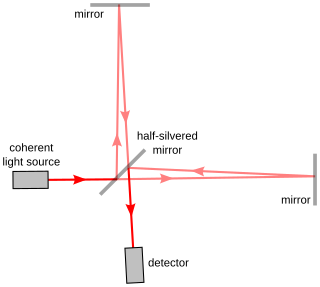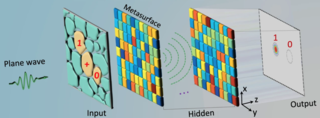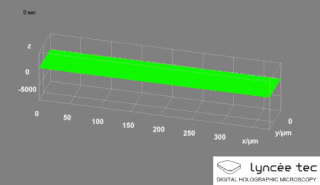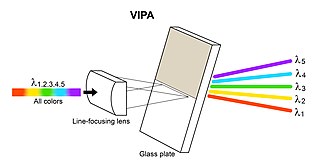Related Research Articles

In antenna theory, a phased array usually means an electronically scanned array, a computer-controlled array of antennas which creates a beam of radio waves that can be electronically steered to point in different directions without moving the antennas. The general theory of an electromagnetic phased array also finds applications in ultrasonic and medical imaging application and in optics optical phased array.

Holography is a technique that enables a wavefront to be recorded and later reconstructed. It is best known as a method of generating three-dimensional images, and has a wide range of other uses, including data storage, microscopy, and interferometry. In principle, it is possible to make a hologram for any type of wave.

Interferometry is a technique which uses the interference of superimposed waves to extract information. Interferometry typically uses electromagnetic waves and is an important investigative technique in the fields of astronomy, fiber optics, engineering metrology, optical metrology, oceanography, seismology, spectroscopy, quantum mechanics, nuclear and particle physics, plasma physics, biomolecular interactions, surface profiling, microfluidics, mechanical stress/strain measurement, velocimetry, optometry, and making holograms.

Adaptive optics (AO) is a technique of precisely deforming a mirror in order to compensate for light distortion. It is used in astronomical telescopes and laser communication systems to remove the effects of atmospheric distortion, in microscopy, optical fabrication and in retinal imaging systems to reduce optical aberrations. Adaptive optics works by measuring the distortions in a wavefront and compensating for them with a device that corrects those errors such as a deformable mirror or a liquid crystal array.

A spatial light modulator (SLM) is a device that can control the intensity, phase, or polarization of light in a spatially varying manner. A simple example is an overhead projector transparency. Usually when the term SLM is used, it means that the transparency can be controlled by a computer.

An optical neural network is a physical implementation of an artificial neural network with optical components. Early optical neural networks used a photorefractive Volume hologram to interconnect arrays of input neurons to arrays of output with synaptic weights in proportion to the multiplexed hologram's strength. Volume holograms were further multiplexed using spectral hole burning to add one dimension of wavelength to space to achieve four dimensional interconnects of two dimensional arrays of neural inputs and outputs. This research led to extensive research on alternative methods using the strength of the optical interconnect for implementing neuronal communications.

An optical vortex is a zero of an optical field; a point of zero intensity. The term is also used to describe a beam of light that has such a zero in it. The study of these phenomena is known as singular optics.
Nanophotonics or nano-optics is the study of the behavior of light on the nanometer scale, and of the interaction of nanometer-scale objects with light. It is a branch of optics, optical engineering, electrical engineering, and nanotechnology. It often involves dielectric structures such as nanoantennas, or metallic components, which can transport and focus light via surface plasmon polaritons.
Holographic interferometry (HI) is a technique which enables the measurements of static and dynamic displacements of objects with optically rough surfaces at optical interferometric precision. These measurements can be applied to stress, strain and vibration analysis, as well as to non-destructive testing and radiation dosimetry. It can also be used to detect optical path length variations in transparent media, which enables, for example, fluid flow to be visualised and analyzed. It can also be used to generate contours representing the form of the surface.
Digital holography is the acquisition and processing of holograms with a digital sensor array, typically a CCD camera or a similar device. Image rendering, or reconstruction of object data is performed numerically from digitized interferograms. Digital holography offers a means of measuring optical phase data and typically delivers three-dimensional surface or optical thickness images. Several recording and processing schemes have been developed to assess optical wave characteristics such as amplitude, phase, and polarization state, which make digital holography a very powerful method for metrology applications .
Computer-generated holography (CGH) is a technique that uses computer algorithms to generate holograms. It involves generating holographic interference patterns. A computer-generated hologram can be displayed on a dynamic holographic display, or it can be printed onto a mask or film using lithography. When a hologram is printed onto a mask or film, it is then illuminated by a coherent light source to display the holographic images.
Optical heterodyne detection is a method of extracting information encoded as modulation of the phase, frequency or both of electromagnetic radiation in the wavelength band of visible or infrared light. The light signal is compared with standard or reference light from a "local oscillator" (LO) that would have a fixed offset in frequency and phase from the signal if the latter carried null information. "Heterodyne" signifies more than one frequency, in contrast to the single frequency employed in homodyne detection.
An optical modulator is an optical device which is used to modulate a beam of light with a perturbation device. It is a kind of transmitter to convert information to optical binary signal through optical fiber or transmission medium of optical frequency in fiber optic communication. There are several methods to manipulate this device depending on the parameter of a light beam like amplitude modulator (majority), phase modulator, polarization modulator etc. The easiest way to obtain modulation is modulation of intensity of a light by the current driving the light source. This sort of modulation is called direct modulation, as opposed to the external modulation performed by a light modulator. For this reason, light modulators are called external light modulators. According to manipulation of the properties of material modulators are divided into two groups, absorptive modulators and refractive modulators. Absorption coefficient can be manipulated by Franz-Keldysh effect, Quantum-Confined Stark Effect, excitonic absorption, or changes of free carrier concentration. Usually, if several such effects appear together, the modulator is called electro-absorptive modulator. Refractive modulators most often make use of electro-optic effect, other modulators are made with acousto-optic effect, magneto-optic effect such as Faraday and Cotton-Mouton effects. The other case of modulators is spatial light modulator (SLM) which is modified two dimensional distribution of amplitude & phase of an optical wave.
Speckle, speckle pattern, or speckle noise designates the granular structure observed in coherent light, resulting from random interference. Speckle patterns are used in a wide range of metrology techniques, as they generally allow high sensitivity and simple setups. They can also be a limiting factor in imaging systems, such as radar, synthetic aperture radar (SAR), medical ultrasound and optical coherence tomography. Speckle is not external noise; rather, it is an inherent fluctuation in diffuse reflections, because the scatterers are not identical for each cell, and the coherent illumination wave is highly sensitive to small variations in phase changes.

A terahertz metamaterial is a class of composite metamaterials designed to interact at terahertz (THz) frequencies. The terahertz frequency range used in materials research is usually defined as 0.1 to 10 THz.

Digital holographic microscopy (DHM) is digital holography applied to microscopy. Digital holographic microscopy distinguishes itself from other microscopy methods by not recording the projected image of the object. Instead, the light wave front information originating from the object is digitally recorded as a hologram, from which a computer calculates the object image by using a numerical reconstruction algorithm. The image forming lens in traditional microscopy is thus replaced by a computer algorithm. Other closely related microscopy methods to digital holographic microscopy are interferometric microscopy, optical coherence tomography and diffraction phase microscopy. Common to all methods is the use of a reference wave front to obtain amplitude (intensity) and phase information. The information is recorded on a digital image sensor or by a photodetector from which an image of the object is created (reconstructed) by a computer. In traditional microscopy, which do not use a reference wave front, only intensity information is recorded and essential information about the object is lost.
Ali Hajimiri is an academic, entrepreneur, and inventor in various fields of engineering, including electrical engineering and biomedical engineering. He is the Bren Professor of Electrical Engineering and Medical Engineering at the California Institute of Technology (Caltech).

An acousto-optic programmable dispersive filter (AOPDF) is a special type of collinear-beam acousto-optic modulator capable of shaping spectral phase and amplitude of ultrashort laser pulses. AOPDF was invented by Pierre Tournois. Typically, quartz crystals are used for the fabrication of the AOPDFs operating in the UV spectral domain, paratellurite crystals are used in the visible and the NIR and calomel in the MIR (3–20 μm). Recently introduced lithium niobate crystals allow for high-repetition rate operation (> 100 kHz) owing to their high acoustic velocity. The AOPDF is also used for the active control of the carrier-envelope phase of few-cycle optical pulses, as a part of pulse-measurement schemes and multi-dimensional spectroscopy techniques. Although sharing a lot in principle of operation with an acousto-optic tunable filter, the AOPDF should not be confused with it, since in the former the tunable parameter is the transfer function and in the latter it is the impulse response.

An electromagnetic metasurface refers to a kind of artificial sheet material with sub-wavelength features. Metasurfaces can be either structured or unstructured with subwavelength-scaled patterns.

A virtually imaged phased array (VIPA) is an angular dispersive device that, like a prism or a diffraction grating, splits light into its spectral components. The device works almost independently of polarization. In contrast to prisms or regular diffraction gratings, the VIPA has a much higher angular dispersion but has a smaller free spectral range. This aspect is similar to that of an Echelle grating, since it also uses high diffraction orders. To overcome this disadvantage, the VIPA can be combined with a diffraction grating. The VIPA is a compact spectral disperser with high wavelength resolving power.
References
- ↑ McManamon P. F.; et al. (May 15, 1996). "Optical phased array technology". Proceedings of the IEEE, Laser Radar Applications. 84 (2). IEEE: 99–320. Retrieved 2007-02-18.
- ↑ Sun J.; et al. (January 1, 2013). "Large-scale nanophotonic phased array". Nature. 493 (195). Nature Publishing Group, a division of Macmillan Publishers Limited: 195–199. Bibcode:2013Natur.493..195S. doi:10.1038/nature11727. PMID 23302859. S2CID 205231845.
- 1 2 3 Fatemi R.; et al. (Nov 12, 2018). "High sensitivity active flat optics optical phased array receiver with a two-dimensional aperture" (PDF). Opt. Express. 26 (23). Optical Society of America: 29983–29999. Bibcode:2018OExpr..2629983F. doi: 10.1364/OE.26.029983 . PMID 30469879.
- ↑ Poulton C.; et al. (2017). "Large-scale silicon nitride nanophotonic phased arrays at infrared and visible wavelengths". Opt. Lett. 42 (1). Optical Society of America: 21–24. Bibcode:2017OptL...42...21P. doi: 10.1364/OL.42.000021 . PMID 28059212.
- ↑ Chung S.; et al. (Jan 2018). "A Monolithically Integrated Large-Scale Optical Phased Array in Silicon-on-Insulator CMOS". IEEE Journal of Solid-State Circuits. 53 (1). IEEE: 275–296. Bibcode:2018IJSSC..53..275C. doi:10.1109/JSSC.2017.2757009. S2CID 1279064.
- ↑ Aflatouni F.; et al. (August 4, 2015). "Nanophotonic projection system". Opt. Express. 23 (16). Optical Society of America: 21012–21022. Bibcode:2015OExpr..2321012A. doi: 10.1364/OE.23.021012 . PMID 26367953. S2CID 15059522.
- ↑ Fatemi R.; et al. (2016). A One-Dimensional Heterodyne Lens-Free OPA Camera. Conference on Lasers and Electro-Optics, OSA Technical Digest (2016). Optical Society of America. pp. STu3G.3. Retrieved 13 February 2019.
- 1 2 Wowk B. (1996). "Phased Array Optics". In B. C. Crandall (ed.). Molecular Speculations on Global Abundance . MIT Press. pp. 147–160. ISBN 0-262-03237-6 . Retrieved 2007-02-18.
- ↑ Eshel, Tamir (7 March 2014). "Successful EXCALIBUR Test Brings DARPA Closer to Compact High Energy Lasers". defense-update.com. Defense Update. Retrieved 9 March 2014.